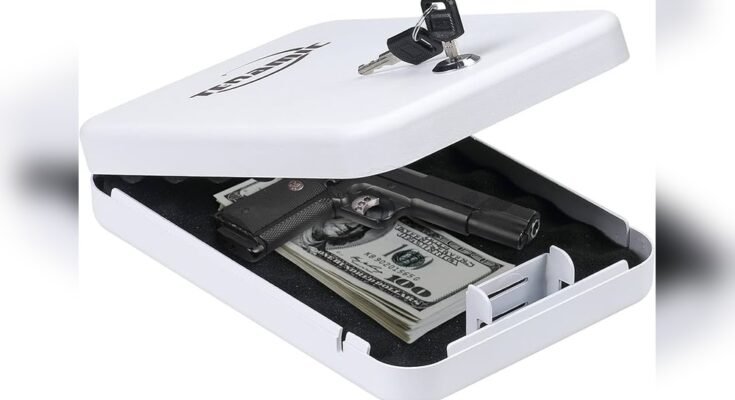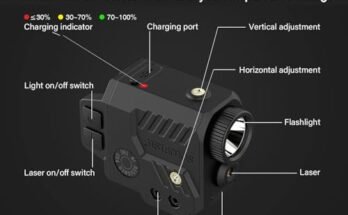When it comes to protecting your pistol, the material of your safe matters more than you might think. You want something strong, reliable, and built to keep your firearm secure from theft or damage.
But what exactly are pistol safes made of? Understanding the materials can help you choose the right safe that fits your needs and gives you peace of mind. Keep reading to discover the key materials used in pistol safes and why they make all the difference in keeping your gun safe and sound.
Common Materials Used
Pistol safes must be strong and secure. The choice of materials affects their safety and durability. Different materials offer various levels of protection. Some materials resist cutting or drilling. Others make the safe heavy and hard to move. Understanding common materials helps in choosing the right safe for your needs.
Steel Types And Grades
Steel is the most common material for pistol safes. It is strong and hard to break. Different grades of steel offer different strength levels. Thicker steel provides better protection. Some safes use hardened steel to resist drills and saws. Steel also helps keep the safe fire-resistant.
Composite Materials
Composite materials combine metals with other substances. These safes often mix steel with plastics or resins. The mix makes the safe lighter but still strong. Composites can absorb impact better than plain steel. They also help reduce noise when opening or closing the safe.
Concrete Reinforcement
Concrete is sometimes used inside the walls of pistol safes. It adds weight and makes the safe harder to break. Concrete fills gaps between steel layers for extra strength. Reinforced concrete safes resist forced entry and drilling. This material also helps with fire protection by keeping heat out.

Steel Construction Benefits
Steel is a popular choice for pistol safes. It offers strong protection for your firearms. The benefits of steel construction make these safes reliable and secure. Here is why steel stands out.
Durability And Strength
Steel is very durable. It can handle heavy use without breaking. This strength keeps the safe intact during impacts or drops. Your pistol stays protected inside a strong steel shell. Steel resists wear and tear better than other materials.
Resistance To Drilling And Cutting
Steel safes resist drilling attempts. Thieves find it hard to cut through steel walls. This makes unauthorized access very difficult. The tough steel slows down or stops break-in efforts. It adds a strong layer of security for your guns.
Weight Considerations
Steel safes tend to be heavy. This weight helps prevent theft by making the safe hard to carry. A heavier safe stays in place during forced moves. However, heavy safes may be harder to move within your home.
Composite And Hybrid Safes
Composite and hybrid safes combine different materials to provide strong protection. These safes use layers of metals, plastics, and other substances. The goal is to protect pistols from theft, fire, and impacts. This mix of materials offers benefits that single-material safes cannot. They balance strength, weight, and resistance in smart ways. Understanding their features helps you choose the right safe for your needs.
Layered Protection
Composite safes have multiple layers of materials. Steel layers add strength and block break-in attempts. Other layers may include plastics or ceramics. These layers stop tools from cutting or drilling through. Hybrid safes combine metals with special fireproof materials. This layered design makes it harder for thieves to break inside. Each layer works together to keep your pistol safe.
Fire Resistance
Many composite safes include fire-resistant materials. These materials slow down heat and flames. They protect pistols from damage during fires. Some safes use concrete or special boards inside. These materials absorb heat and prevent it from reaching the gun. Fire resistance ratings show how long a safe can protect contents. This feature is important for safe storage in emergencies.
Impact Absorption
Composite and hybrid safes can absorb shocks well. Layers of different materials cushion impacts from drops or hits. This helps stop internal damage to the pistol. Some safes have foam or rubber layers inside. These layers reduce vibrations and sudden force. Impact absorption keeps your gun safe from accidental damage. It adds extra security beyond just theft protection.

Fireproofing Materials
Pistol safes must protect firearms from fire damage. Fireproofing materials play a key role in this protection. These materials help keep the safe’s interior cool during a fire. They prevent heat from reaching the guns and ammunition inside. Different components work together to ensure fire resistance.
Insulating Components
Insulating materials block heat from entering the safe. Common types include fireboard and ceramic fiber. Fireboard is a dense, heat-resistant board that slows heat transfer. Ceramic fiber is lightweight and withstands very high temperatures. These materials line the safe’s walls and door. They create a barrier against intense heat.
Intumescent Seals
Intumescent seals expand when exposed to heat. This expansion fills gaps around the safe door. It stops smoke and hot gases from entering. These seals are often made of special rubber or graphite. They help maintain the safe’s internal temperature. This keeps firearms safe during a fire.
Fire Rating Standards
Fire ratings show how long a safe can resist fire. Ratings depend on testing at specific temperatures. Common ratings include 30 minutes, 60 minutes, or 120 minutes. Tests measure how long the internal temperature stays below damage levels. Look for safes with certified fire ratings. This ensures reliable fire protection for your firearms.
Locking Mechanism Materials
The locking mechanism is the heart of any pistol safe. It controls access and ensures security. The materials used in these parts affect strength and reliability. Strong materials resist tampering and wear over time. Understanding these materials helps you choose the right safe for your needs.
Steel Bolts And Bars
Steel is the most common material for bolts and bars. It is tough and hard to break. These parts lock the door tightly in place. Hardened steel resists cutting and prying attacks. The thickness of bolts also adds extra protection. Quality steel bolts keep the safe secure against forced entry.
Electronic Lock Components
Electronic locks use various metals and plastics. Circuit boards control the lock’s functions. Metal contacts and springs ensure proper electrical connections. The keypad is often made of durable plastic or metal. Batteries power the lock, and quality parts increase lifespan. Good materials in electronics reduce failure risks and improve safety.
Mechanical Lock Parts
Mechanical locks contain gears, springs, and tumblers. These parts are usually made from steel or brass. Brass resists rust and wears smoothly over time. Steel parts add strength to prevent break-ins. Precision in these materials ensures the lock works correctly. Solid mechanical parts create reliable and long-lasting locks.

Material Impact On Safe Ratings
The materials used in pistol safes play a big role in their safety ratings. These ratings tell you how well the safe can protect your valuables. Different materials affect the strength, fire resistance, and durability of the safe. Choosing the right material means better protection for your firearms and important items.
Security Ratings Explained
Security ratings show how strong a safe is against theft. Safes made from thick steel often get higher ratings. Hardened steel resists cutting and drilling better than thin metal. Many safes also have layers of other materials inside for extra protection. These ratings help buyers know which safes can stop burglars.
Fire Resistance Ratings
Fire resistance ratings tell how long a safe can protect contents from heat. Materials like concrete and fireboard inside the safe help block heat. Steel alone heats up fast and offers less fire protection. Safes with good fireproof materials keep guns and papers safe longer during fires. Ratings usually show how many minutes the safe can withstand fire.
Impact Of Material Quality
High-quality materials make safes stronger and longer lasting. Cheap metals can bend or break easily. Good welds and thick walls add to the safe’s toughness. Inside materials also affect moisture and heat protection. Quality materials improve both security and fire resistance scores. This means better overall safety for your pistol safe.
Maintenance And Longevity
Proper maintenance keeps pistol safes strong and reliable. Longevity depends on the safe’s material and care. Regular checks help avoid costly repairs. Small efforts extend the life of your safe.
Corrosion Prevention
Steel is common in pistol safes but can rust over time. Wipe the surface with a dry cloth to remove moisture. Use anti-rust sprays designed for metal surfaces. Keep the safe in a dry place to stop corrosion. Rust weakens the safe and harms its appearance.
Material Wear And Tear
Hard materials like steel resist scratches and dents better. Thin metals may bend or dent with rough use. Check hinges and locks often for signs of damage. Lubricate moving parts to keep them working smoothly. Replace worn parts quickly to avoid bigger problems.
Environmental Considerations
Humidity and temperature changes affect safe materials. High humidity can cause rust and mold inside the safe. Avoid placing the safe in damp or hot areas. Use moisture-absorbing packets to protect the inside. Proper environment control keeps the safe in top shape.
Frequently Asked Questions
What Materials Are Commonly Used In Pistol Safes?
Pistol safes are commonly made from steel, alloy metals, and reinforced composites. Steel is preferred for its strength and durability. Some safes feature fire-resistant materials for added protection. High-quality safes combine materials to resist tampering and ensure long-lasting security for firearms.
Why Is Steel The Preferred Material For Pistol Safes?
Steel provides excellent strength and resistance against break-ins. It is tough, durable, and difficult to cut or pry open. Steel also offers good fire resistance. These properties make steel the top choice for ensuring firearms stay secure and protected from unauthorized access.
Are Fire-resistant Materials Used In Pistol Safes?
Yes, many pistol safes include fire-resistant materials like gypsum or ceramic insulation. These materials protect firearms from high temperatures during a fire. Fire-resistant safes help preserve guns and ammunition, increasing safety and peace of mind for gun owners.
How Do Composite Materials Enhance Pistol Safe Security?
Composite materials combine metals with reinforced fibers for added strength. They provide resistance against drilling, cutting, and impact. Using composites enhances durability without significantly increasing weight. This makes safes both secure and easier to handle or install.
Conclusion
Pistol safes use strong materials like steel and reinforced alloys. These materials keep your firearms safe and secure. Some safes have fire-resistant layers for extra protection. Choosing the right material helps protect against theft and damage. Understanding these materials makes picking a safe easier.
Safety and durability matter most when storing pistols. Always pick a safe built to last and protect well. Your firearms deserve solid, reliable protection every day.



